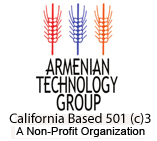July 5, 1996
A pair of recently signed exchange agreements between the Republic of Armenia and two California universities have set the stage for a busy spring on Armenia’s farms.
The agreements, developed through the initiative of the Armenian Technology Group (ATG), involve the School of Veterinary Medicine of the University of California at Davis, the School of Agricultural Sciences and Technology of the California State University at Fresno, and the Armenian Academy of Agriculture, which operates under Armenia’s Ministry of Food and Agriculture.
The signing ceremonies took place in California in October 1995 during a visit by Armenia’s top agricultural officials. In addition to meeting with university administrators, Minister Ashot Voskanian and Deputy Minister Ishkhan Mardirossian toured several farming and dairy operations in Central California’s agricultural heartland. In Fresno, they were hosted at a reception in the home of Vahan and Anoush Chamlian.
The agreements are part of a larger effort by ATG to improve animal and public health in Armenia. Since the disintegration of the Soviet Union, livestock herds in the newly independent republic have been decimated by shortages of feed and a breakdown in the system of disease control throughout the Caucasus region. Armenian farmers have been forced to slaughter thousands of animals facing starvation or infection. The prospects for Armenian agriculture, however, have begun to turn around. The coming year promises to be the most productive yet since Armenia underwent a sweeping land privatization program in 1991.
Representatives of ATG, a California-based non-profit organization dedicated to promoting Armenia’s agricultural self-sufficiency, are hoping that Armenia’s new links to the University of California at Davis and the California State University at Fresno will help Armenians apply the advances of American agriculture to the specific challenges of the republic, especially with respect to the meat and dairy industries.
“We do not want to repeat the management errors of the 20th century dairy industry in Armenia,” explained Dr. Jack Morse, a veterinarian from Turlock, California, and an ATG board member. “In Armenia, we should start implementing the 1990s approach to dairy management to move the republic straight from the 1930s- and 1940s-era systems that they have now to the techniques of the 21st century.”
One element working in Armenia’s favor is a legacy of top-notch scholarship in the agricultural sciences. ATG’s executive director, Varoujan Der Simonian, notes that Armenia’s veterinarians and agronomists have a solid grounding in the research of their respective fields and are receptive to new ideas. The emphasis now is on applying the tools and technologies available in the West.
“After 70 years of totalitarian rule, our country is now open to the Western world,” said Deputy Minister Ishkhan Mardirossian. “We are very anxious to see what is done in every field.”
The recently concluded agreements will give Armenians an opportunity to draw on the expertise of two of America’s leading centers in the agricultural sciences. Through the exchange program with the University of California at Davis, Armenian professors and graduate students will participate in joint research projects with their American colleagues, and will be exposed to the latest techniques for the control and prevention of diseases affecting both livestock and humans. This spring, a group of University of California veterinarians will travel to Armenia to analyze the problems facing Armenia in the area of animal/public health. Armenia’s cooperation agreement with the California State University at Fresno will likewise facilitate the exchange of research and faculty members.
ATG is working to ensure that the new program of scholarly exchange fits into a broader effort to rebuild Armenia’s meat and dairy industries, and remedy the republic’s chronic shortage of animal feed. In December 1995, an ATG delegation visited Armenia to evaluate the needs of local agriculture and to lay the groundwork for the implementation of the sister university programs. ATG signed an agreement of cooperation with the Ministry of Food and Agriculture designed to strengthen Armenia’s private farming sector. In addition, the ATG delegation met with U.S. Ambassador to Armenia Peter Tomsen, as well as with officials from the U.S. Agency for International Development (AID) and the U.S. Department of Agriculture, to coordinate assistance activities.
This spring, funding from AID will enable ATG to plant 10,000 acres of Armenia’s highlands with specially selected varieties of American alfalfa seed. The varieties have been chosen after several years of testing by ATG to determine which strains of alfalfa are best suited to conditions in Armenia.
The hay harvested from the spring planting will help launch a network of model dairies and livestock operations being set up by ATG and the Armenian Ministry of Food and Agriculture. ATG’s core of volunteer specialists and Armenian officials are hopeful that their efforts will soon pay off in increased meat and milk production for Armenia’s population.
The animal/public health project is one of several programs that ATG has implemented in Armenia in the agricultural sector since its creation in 1989. ATG has received grants from the U.S. Agency for International Development, the United Nations High Commissioner for Refugees, and the Lincy Foundation.
For more information about how you can help Armenia’s farmers, contact the ATG office at (559) 224-1000 or by e-mail (info@atgusa.org). Tax-deductible donations can be sent to ATG; 1300 E. Shaw, Suite 149; P.O.Box 5969; Fresno, CA 93755-5969.
You may also donate to ATG online.

Follow Us